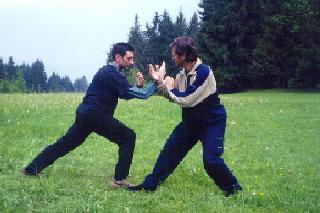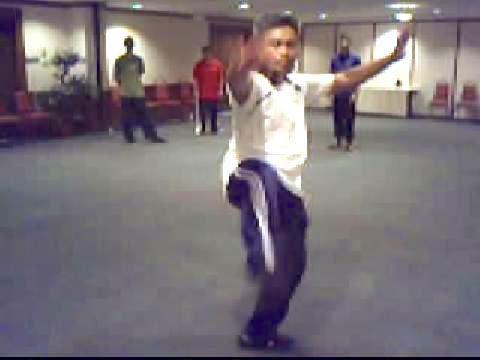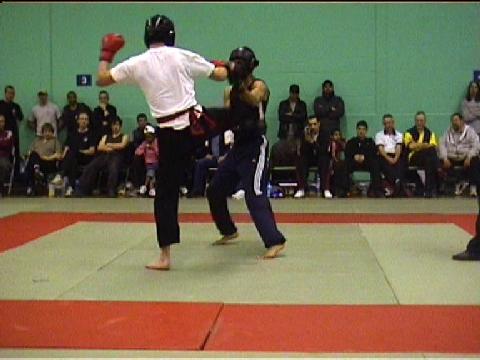FOLLOWING THE OPPONENT'S MOMENTUM

Sifu Riccardo of Shaolin Wahnam Italy yields as Sifu Javier of Shaolin Wahnam Spain pushes forward with an attack. Notice that Sifu Riccardo maintains good balance while sinking onto his back leg.
The following discussion is reproduced from the thread A Discussion on Yielding started in the Shaolin Wahnam Discussion Forum on 14th February 2006. The name of a main contributor to this thread is removed as requested by him, and is replaced by “Challenger”. As the discussion is long, it is presented here in parts.
 Sifu Marcus Santer
Sifu Marcus Santer
Instructor, Shaolin Wahnam England
22nd February 2006
Let us examine the following concepts and techniques advocated by a master.
'Tai-Chi Chuan defensive responses generally move forward into the attack, rather than retreating from it.'
This is against fundamental Tai Chi Chuan principles. This concept of moving into the attack advocates meeting force with force, whereas Tai Chi Chuan is particularly well known for avoiding meeting force with force.
His mention of
'rather than retreating from it'
shows a basic understanding of yielding. 'Retreating from it', or yielding, is only the first part of a counter, followed by deflecting, then continuing to counter-strike the opponent.
I'll have some more for you tomorrow, until then I wish you well with your practice.
Kind regards
Marcus
Namo Amitabha Buddha Namo Amitabha Buddha Namo Amitabha Buddha
Sifu Marcus Santer
Instructor, Shaolin Wahnam England
26th February 2006
Today I'd like to explain why I find the following statement to be flawed
''Peng' or 'Ward-Off' for example expresses dynamic forward motion both energetically and physically.'
It has been several years since I practiced Tai Chi Chuan regularly, but I can still remember some of the basic principles. You can imagine my surprise then that somone of Sifu Stiers experience would write such a statement. I find it hard to believe that Sifu Stier does not understand or appreciate basic Tai Chi Chuan principles like:
- Rotating from the waist
- Before one moves forward, he moves back
- Before one moves to his left, he moves to his right
The 'peng' technique, or 'Immortal Waves Sleeves' as it is called in Wahnam Tai Chi Chuan, is instrumental in teaching and learning these principles. Both energetically and physically, 'peng' or 'ward-off' does not express dynamic forward motion; it expresses spiral circular motion.
In other words, when a Tai Chi Chuan practitioner performs the 'peng' or 'ward-off' technique correctly, both his energy flow and his physical movement moves not directly forward but in a spiraling and circular manner.
I'll post more tomorrow. Enjoy your practice.
Kind regards
Marcus
Namo Amitabha Buddha Namo Amitabha Buddha Namo Amitabha Buddha
Zhang Wuji
Shaolin Wahnam Student
27th February 2006
The word “yielding” can be misleading. The word used in Chinese means “neutralising” and even then, that is not complete. What the word really means in Chinese is to change, transform and even reverse. If one accepts this definition, then it is possible to meet an oncoming attack without hard force, and in a forward, spiraling manner.
Also, while the Taijiquan classical principles are universal, they are expressed in words, which are provisional. So, one interpretation of the principles applies in one context and not another (much like the postures themselves). For me, the classics mean something different at each stage of my development, not that they drastically change in meaning, but I see new and deeper aspects all the time.
Sifu Marcus Santer
Instructor, Shaolin Wahnam England
27th February 2006
Good morning everybody,
Zhang Wuji, thank you for your contribution to this thread, I found your post food for thought.
Today, I'd like to explore this comment, as I believe there is a lot we can learn from its examination:
“So...if I respond to an opponent's jab or straight punch by advancing toward him with either foot while using 'Ward-Off' Form as played in the Set, I will be shifting my weight forward into a Bow and Arrow Stance.”

Joko of Indonesia performing “Cross Hand Thrust Kick in chi flow during the Intensive Taijiquan Course of January 2006 in Malaysia. A video clip showing this performance will be released later.
Using “peng” against an opponent's jab is low-level. It shows poor understanding of timing and spacing, two very important concepts in combat. It also runs counter to the tenet of using ones strength against an opponent's weakness, In fact, advocator response shows the reverse, i.e. using his weakness against an opponent's strength. Let me explain.
A jab is technically much faster than a 'peng' technique. Even when a 'peng' is performed correctly, there are many variations a jabbing opponent can make to clinch victory. For example, he may pull back the jab, and jab again into his face while the 'peng' continues its motion. Or he may move forward and elbow his jaw.
There are many effective techniques in Tai Chi Chuan against the fast jab. For example, the Tai Chi Chuan practitioner may use 'Cross Hand Thrust Kick'. He moves diagonally aside, spreads his hands above to distract the opponent, and simultaneously kicks him below (using the strategy "Signal high, strike low"). Here he uses spacing to overcome the opponent's timing. No matter how fast the opponent's jabs are, the Tai Chi Chuan practitioner spaces himself in such manner that they cannot reach him despite their speed.
Nevertheless, if for any reasons the Tai Chi Chuan practitioner wishes to 'ward off' the jab, he should use 'slap hand' instead of 'peng'. A good technique is 'Punch Below Sleeves'. If the opponent jabs with his right hand, for example, assume a left Bow-Arrow Stance and ward off the jab at his elbow with your left palm -- not by moving your left palm but by rotating your waist from left to right in a clockwise movement. Still controlling his arm at his elbow with your left palm, thrust your right vertical fist into his right ribs.
Take note that this warding-off movement is circularly backward, and not directly forward as advocated. Suppose the opponent's jab is coming in a direction from north to south. The advocator's 'peng' moves from south to north, or from south-west to north-east. This is going against the opponent's momentum, and is against Tai Chi Chuan principles. Your ward-off with the palm moves from north-west to south-east. This is using the opponent's momentum, and follows Tai Chi Chuan principles.
That's all for now as I have to get ready for my "other" job
Kind regards,
Sifu Riccardo Puleo
Yielding : mind or form ?
Many interesting contribution to this thread !
Between them, I like the definition of yielding posted by Zhang Wuji:
"What the word really means in Chinese is to change, transform and even reverse. If one accepts this definition, then it is possible to meet an oncoming attack without hard force"
Reading this definition brought me back to the personal experience field, rather than on the level of rational thinking or cultural knowledge.
I have been so lucky to receive teaching directly from a Grandmaster; well, I remember some situations in which I was invited, for training purposes, to carry an attack. If I was allowed, for training purposes, to get in touch with Grandmaster's arm, trying to grip it for example, I got the impression that it almost "liquified"!
I got the impression that Grandmaster's body, under an attack situation, can become so soft that it cannot be significantly hurt or blocked.
I intuitively (and by personal experience) believe that this "transformation" (see Zhang Wuji definition) can be viewed as high level example of "yielding". And indeed, this kind of "yielding" is mostly achieved through a state of mind, and in a minor part as a result of external forms or techniques.
I also believe, based on personal experience, that only mind control can instantly change the Grandmaster's yielding arm, liquid as water, into a weapon arm, solid as rock!
Riccardo
Sifu Robin Gamble of Shaolin Wahnam England using “Cross-Hand Thrust Kick” against an opponent in an All Britain Taijiquan Open Sparring Competition where he won.
Marcus
Instructor, Shaolin Wahnam Italy
27th February 2006

LINKS
Courses and Classes
